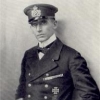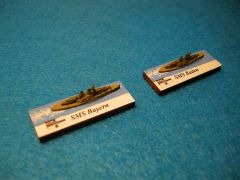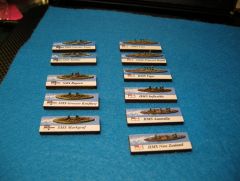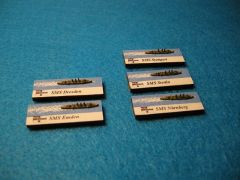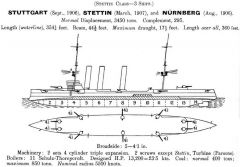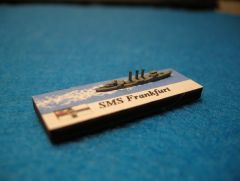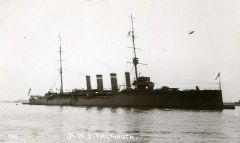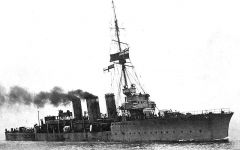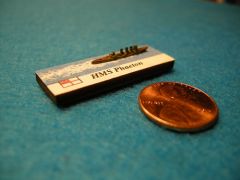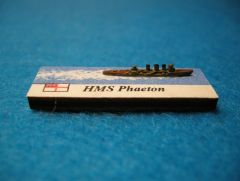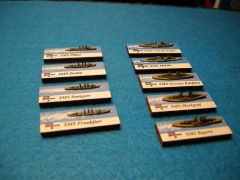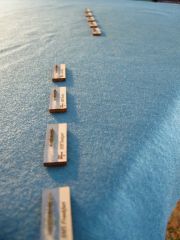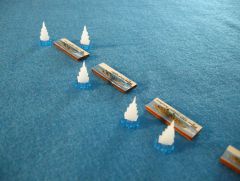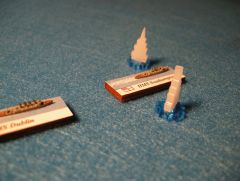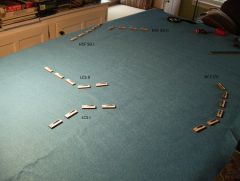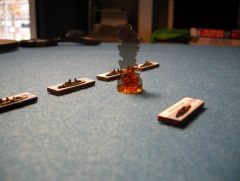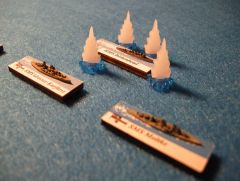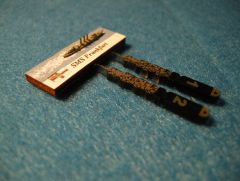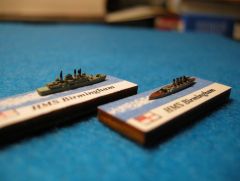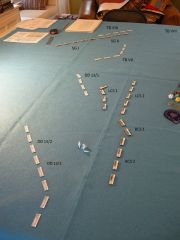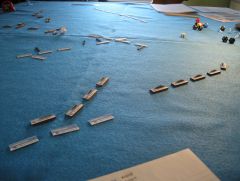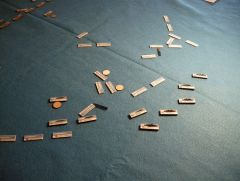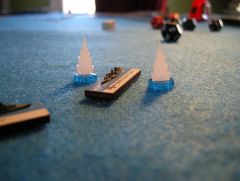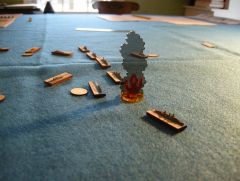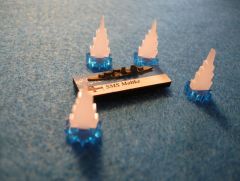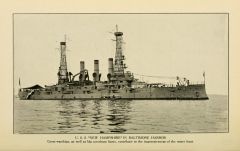At last...sorry for the long delay:
Scenario - Sunderland, August 1916
HSF sets sail at 2100 on August 18. Scheer’s departure is observed and relayed to the Grand Fleet by British Intelligence. Jellicoe orders Beatty’s battlecruiser force to intercept with the main-body following in support.
Hipper’s force is to deliver a bombardment of Sunderland with Scheer’s main-body following closely behind, hoping to come to grips with an intercepting British force.
At 0600 HMS Nottingham of Goodenough’s 2nd Light Cruiser Squadron is torpedoed by U-52. In the confusion it is initially reported she struck a mine, causing Jellicoe, thirty miles behind, to temporarily turn his main-body and the 5th Battle Squadron back to the north for fear of steaming into an uncharted minefield. Beatty, believing any minefield is to his immediate east or northeast, disregards the presumed danger and continues with the battlecruisers on his southeasterly course. At 0900 Goodenough reports that Nottingham was in fact lost to a submarine attack, but by now the battlecruiser force is separated from Jellicoe’s main-body by nearly 100 miles.
At 1215 Scheer, based on faulty reports by Zeppelin L-13, turns his main-body southeast toward an enemy force (Harwich) he believes to be the British main-body. Hipper briefly continues on his northwesterly course to close on the English coast.
At 1250, with his position just 45 miles due east of Scarborough, Hipper receives a report from Moltke of smoke on the horizon off the starboard bow. Captain Zenker receives confirmation of same from his lookouts on Von der Tann, whereby Hipper orders a sharp change of course to the east-northeast and an increase in speed to 20 knots.
Weather is clear with a slight wind.
Order of Battle
Battlecruiser Squadron (Sir David Beatty)
1st Battlecruiser Squadron (Osmond Brock)
HMS Princess Royal
HMS Tiger
HMS Lion
2nd Battlecruiser Squadron (William Pakenham)
HMS New Zealand
HMS Australia
HMS Inflexible
1st Light Cruiser Squadron (Edwin Alexander-Sinclair)
HMS Galatea
HMS Phaeton
HMS Inconstant
HMS Cordelia
2nd Light Cruiser Squadron (William Edmund Goodenough)
HMS Southampton
HMS Dublin
HMS Birmingham
HMS Birkenhead
HMS Chester
Scouting Force (Franz Hipper)
1st Scouting Group (Franz Hipper)
SMS Von Der Tann
SMS Moltke
SMS Grosser Kurfürst
SMS Markgraf
SMS Bayern
2nd Scouting Group (Friedrich Boedicker)
SMS Pillau
SMS Stettin
SMS Stuttgart
SMS Frankfurt
Opening Moves
Spotters soon report the ships are five British four-funneled light cruisers of the Town-class, proceeding at 22 knots on a southeastward heading. Hipper orders speed be reduced to 17 knots with a slight turn to the north-northeast. At 1314 Von der Tann opens on Southampton at 18,400 yards and Moltke fires on Dublin. For the next twelve minutes the Germans fire continuously at the light cruiser force. No hits are observed. Hipper orders Boedicker and Scouting Group II to close up behind his line.
German battle-line at 1320 on a northeast heading.
At 1326 six British battlecruisers come into view on a southeastward heading steaming at 21 knots. The light cruisers have now turned due east. At 1332 Hipper turns his fire on the battlecruisers. Twelve minutes later Von der Tann scores a hit on Australia’s secondary. At 1350 at a range of 18,000 yards Moltke hits New Zealand (secondary) and Von der Tann puts a round onto Inflexible (hull). Tiger manages a 13.5” hit on Markgraf at 16,800 yards but it fails to penetrate.
Hipper orders a turn north and reduces speed to 14 knots. At 1402 Bayern sends a 15” round into Princess Royal, striking her at the waterline causing minor flooding (hull-box). Ten minutes later Moltke hits Australia twice from a range of 14,800 yards, disabling ‘A’ turret and scoring a hull-box. Grosser Kurfurst knocks down Lion’s mainmast and disables her starboard torpedo-tubes.
The German capitals suffer ineffective fire by Beatty's battlecruisers.
Goodenough’s LCS II now obliquely crosses Hipper’s bow and begins to once again take fire from the German capitals. Southampton is struck twice by Von der Tann, the first 11" round resulting in a starboard gun-mount wrecked. A second penetrates the hull but fails to explode, passing through a storage locker, the engine deck and one of her fuel bunkers before exiting the opposite side of the hull (hull-box). Dublin and Birkenhead come under fire but escape with near-misses. At 1424 Hipper orders an 18-degree turn to the northwest and increases speed to 19 knots.
HMS Southampton and Light Cruiser Squadron II under fire.
At 1430 Tiger suffers a near-catastrophic hit forward on turret A, penetrating deep into the ship while showering the bridge with splinters. Captain Henry Pelly immediately orders the forward magazines flooded, but both Turrets A and B are disabled. With Turret Q out of action from the start, Tiger has only her aft turret and most of her secondary operable.
Beatty feels Princess Royal’s deck shudder beneath his feet as two rounds from Von der Tann slam into her. The first takes out a starboard 6” gun-mount beneath the bridge, the second holes her at the waterline below Turret A (hull-box). New Zealand, fourth in line, is struck on the forecastle by Grosser Kurfurst but the shell fails to penetrate.
Relative positions at 1418.
At this point Beatty is nearly apoplectic. Over the last thirty-four minutes his BC’s have fired fifteen salvoes with just a single hit resulting in minor damage to Von der Tann. He orders a 36-degree turn to the southeast replicating Hipper’s turn to the northwest, and demands that Goodenough and Alexander-Sinclair stop fiddling about and make a run at the enemy. The two lines will pass at an approximate range of 11,000 yards and a combined speed of 40 knots.
Deeply Disturbing…They’ve Got To Do Better
As the range closes gunnery turns deadly. At 12,000 yards Lion puts a 13.5” onto Markgraf’s aft turret, disabling it. New Zealand finds Von der Tann taking out her turrets A and D.
For their part the Germans begin laying the wood to the British BC’s. Moltke drives an 11” into Tiger’s last remaining operable turret, leaving Capt. Pelly to contemplate his ship’s future. Grosser Kurfurst holes Princess Royal again, her speed dropping to 12 knots, down by the bow with serious flooding. Markgraf destroys New Zealand’s turret D and jams her rudder hard-to-port (quickly repaired during the next damage-control phase), while Bayern manages a hit on Australia, taking out a second 4” on her starboard side adjacent to her forward funnel.
Beatty’s BCS force is suffering. Princess Royal has four hull-boxes destroyed and Tiger has lost all of her main armament and flooded her forward magazines. Lion is relatively unscathed with just her mainmast destroyed and her starboard torpedoes disabled.
BCS-2 is a bit better off. New Zealand has lost turret D and a single 4” mount. Australia has lost turret A, both of her forward starboard 4” mounts and one hull box. Inflexible has one hull hit.
Hipper has issues as well. Von der Tann, his flag, has turrets A and D disabled, torpedo tubes damaged and is down 1.5 hull-boxes. Moltke has lost her starboard torpedo tubes, her searchlight mount and 0.5 hull-boxes. Markgraf has lost one of her two aft turrets. Kurfurst and Bayern are undamaged.
The British commander decides he will complete the pass and see what happens. Meanwhile he orders his light-cruisers to flank-speed to apply pressure to the German capitals. Fortunately German fire turns ineffective and the BC’s suffer minimal further damage.
The capitals now turn their attention to the onrushing light-cruisers. Goodenough closes to extremely close range (less than 3,000 yards at one point) attempting to launch a coordinated torpedo attack, but his crews have difficulty developing firing solutions when constantly having to turn inside the German line. Individual ships sporadically fire torpedoes without effect. For his trouble Birkenhead is shot to pieces and sunk, while Chester suffers a hit to her forward magazine, blowing up spectacularly. Southampton, via a series of turns abreast temporarily moves to the rear of the line of CL’s, probably saving her. Dublin and Birmingham come through with only minor damage.
HMS Chester suffers a magazine explosion and is vaporized.
Alexander-Sinclair’s actions are inconsequential. After nearly crossing-the-tee LCS-1 veers off to the northwest and takes a beating enroute. Inconstant is hit seven times, ending her day with half the ship awash and destroyers preparing to come alongside. Cordelia has her two main guns knocked out with most of her aft wrecked.
Boedicker does no better. Every ship in Scouting Group II fires torpedoes at the British BC’s at close-range to no effect. Frankfurt, having drilled incessantly on torpedo tactics closes to less than 2,800 yards before firing her two torpedo-mount broadside…nothing. She suffers a hit to her bulkhead #3 by Lion, flooding half the ship before the crew manages to staunch the inrush of water to limp off.
Beatty turns away at 1518 to regroup. He has four BC's in servicable shape. Princess Royal is struggling with heavy flooding and Tiger is a wreck topside. Hipper contemplates giving chase but is recalled by Scheer. Captain Zenker orders Von der Tann to begin burying her dead.
Observations
These games always seem to start with an almost unbearable amount of cautionery maneuvering...no one wants to commit too soon or from a poor position, taking a pasting in the process. While this is somewhat historically accurate, it often feels contrived, a product of the conceptual limitations of the table-top. For play purposes a running engagement always seems to work better than the head-on clash of a meeting engagement where the two sides approach from opposite directions.
I tried to build the scenario within the confines of actual events, constructing something that wouldn't be too implausible. Scheer allowing Hipper to continue on after he turned south toward a suspected Grand Fleet might be a stretch, but Hipper was known to take liberties with his superior. The raids executed by the HSF early in the war were timed to reach their target typically at or shortly before dawn. It seems peculiar that Hipper was still so far from Sunderland at mid-day, when a calculation of a reasonable speed from the 2100 departure time the evening before could have put him off the target by 0700. Had Hipper completed his bombardment of Sunderland and turned away earlier in the day it is certain that Beatty would have been trying to run Hipper down from behind.
The scenario played out about as expected. Beatty’s battlecruisers were largely ineffective throughout. Princess Royal's gun-layers should be shot, having fired nine salvoes over nearly an hour-and-a-half before registering a hit, fifteen in total scoring only three times before encountering the German light-cruisers at short range. Many hits by the 12” BC’s were ineffective due to poor-penetration factors at long-range. Bayern was repeatedly hit by Australia and Inflexible to no effect. Abysmal die-rolling is only part of the story…it’s tough to be the British player.
For the Germans with their heavier armor it would seem appropriate to close the range as quickly as possible and skip all of the posturing. Presuming Hipper can achieve a reasonable firing line he should be able to make hash of Beatty's BC's at medium range. Beatty's lighter armor and poor shooting (those D20's make it painful to watch) are a major disadvantage, not to be overcome by superior speed. While Bayern shot poorly on this day, she more than any other heavily tips the scale in Hipper's favor.
HMS Birkenhead shortly before she's dispatched by Grosser Kurfurst and Moltke.
The interplay of the armor/penetration factors and the equivalent damage multipliers gets a bit confusing. The flow of the game broke down a number of times due to confusion here. Incorrect application of the multipliers added greatly to the life of the British CL’s…once corrected folks started getting extinguished rather rapidly.
Torpedo attacks are just brutally frustrating, appropriately based on historical fact. Of six attacks launched no hits were scored. A reread of those rules would seem to be in order. In a game played with ODGW staff at Historicon a number of years ago it seemed that torpedoes stayed in play for a number of turns…if so, we’re definitely not playing them properly. (Edit::We subsequently realized what we were balling up on the torpedo table and how fish remain in play for up to three or four turns.)
Frankfurt launches her torpedoes.
That said, it was great fun. There’s enough here to entertain four Brit players and two Germans (throw in all of the destroyers and you could add another two or three players). Played 154 scale minutes in roughly six hours. Secondary and tertiary gunfire was minimal, which helped keep the gunnery rounds moving. We had limited space so we couldn’t deploy the floating-table technique…used a single table and a 50% scale reduction for gunnery (i.e. ten centimeters equaled 2,000 yards). Gave the same result but looked silly at times.
Definitely a replay tee’d up for Christmas break, this time with the four additional light-cruisers and maybe, just maybe, all those freakin’ destroyers.
Maybe.
Healey


